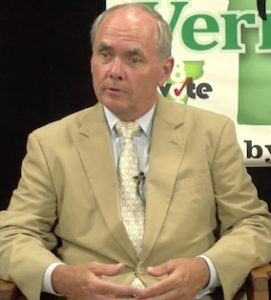By Bill Moore
It hardly seems possible that this week marks the end of December, the year’s end. We will soon be putting 2017 in the rear-view mirror and starting with a clean slate.
The truth is, most businesses have already made plans for 2018. So, how do things look as we wrap up 2017?

Bill Moore is president and CEO of the Central Vermont Chamber of Commerce.
According to the most recent information from the federal Office of Management and Budget, the country has been experiencing 3 percent growth for the past three quarters, and that number appears to be holding for the fourth quarter. Growth like this has not been experienced since before the Great Recession.
According to the Vermont Department of Labor, the Gross State Product (GSP) is the broadest measure of economic activity in the state. The data from 2016 is the most current, and shows Vermont’s GSP growing at a rate of 2.6 percent.
During the same period, service providing industries grew by 3.5 percent, while goods producing industries contracted by 2.3 percent. The fastest growing industries were educational services (+10.6 percent), administrative and waste services (+8.5 percent) and arts, entertainment and recreation (+6.8 percent).
Industries that experienced contraction included agriculture, forestry, fishing and hunting
(-7.9 percent), mining (-12.3 percent), manufacturing (-3.3 percent) and utilities (-16.2 percent).
Private ownership grew by 2.4 percent, while government ownership grew by 3.6 percent. This could certainly become problematic if the trend continues.
Our statewide unemployment for September 2017 (most current data) is at 2.9 percent, down from 3.0 percent in August. Our total non-farm employment for September stood at 317,600 against 316,500 in August 2017.
The Vermont Department of Labor tells us that the average wage statewide in 2016 was $45,059. In Washington County average wages were $48,309.
In 2016, the leading employment sector was service providing (21,676), followed by manufacturing (2,243) and construction (1,295). There were 32,949 jobs in Washington County in 2016 of which 25,402 were in the private sector. Government jobs accounted for the remaining 7,547 jobs.
In answer to the earlier question, “How are we doing,” it would appear that we have a good healthy mix in the economy, without an over-dependence on any one industry sector. We are growing the economy, albeit at a relatively slow pace. While the 2017 numbers are not yet available, a couple of other indicators present a somewhat favorable forecast for 2018 if trends continue.
Looking at some numbers for this fiscal year against the same period in the last fiscal year, General Fund collections are up slightly, $350.1 million against $349.6 million. State sales and use tax collections are higher, $64.8 million versus $61.8 million. Corporate income tax collections are off, $19.4 million compared to $23.5 million in FY 2017. The Transportation Fund reports an increase to $70.6 million from last year’s $67.9 million. The Education Fund (non-property tax component) grew to $49.3 million, up from $46.7 million in the last fiscal year.
Importantly, residential building permits year-to-date are at 1,476 compared to last year’s 1,463. The estimated value of those housing units is $329,544,000, up from 324,007,000. This trend, if continued, will help to resolve a critical housing shortage that is challenging the state.
Earlier this year, the governor and general assembly, worked together and created a state budget with no new taxes and no new fees. Both should agree to do the same in the up-coming session beginning in January. Steady, sound fiscal policies will lead to a further strengthening of the economy, more private investment and higher paying jobs for all Vermonters.
Bill Moore is president and CEO of the Central Vermont Chamber of Commerce.



How do we solve the housing and affordable shortage if the average dwelling is $330,000?